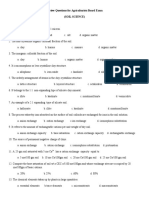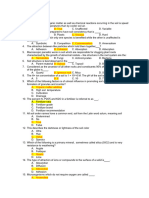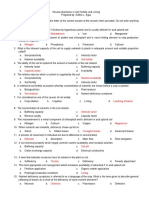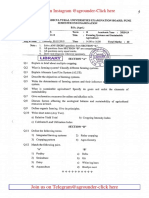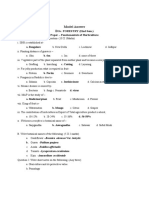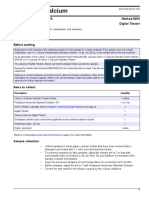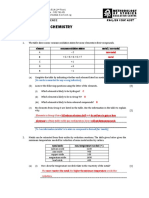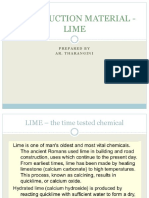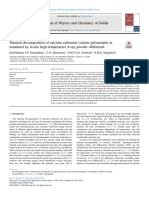OBJECTIVES 1
Course no. - SSAC-242
Course title- Problematic soil and their management
1. Which fertilizer produces acidity in soil?
(A) Ammonium sulphate (B) Sodium nitrate
(C) Calcium ammonium nitrate (D) Calcium nitrate
Ans. a
2. Which among the following salt is also called black alkali?
a) Na2CO3 b) Na2SO4
c) NaCl d) NaOH
Ans. a
3. Solonchak soil is the other name for ____________
a) Alkali Soils b) Sodic Soils
c) Saline-alkali soils d) Saline soils
ans: d
4. Dolomitic limestone is favored over other liming materials when which
essential nutrient element is in low supply?
a) Calcium b) Potassium
c) Magnesium d) Sodium
ans. c
5. Aluminum is considered to be an acid cation because ______
a) It can exchange with Ca2+ ions b) It hydrolyzes in water, releasing
H+ ions
c) It is toxic to plant roots c) all of the above
ans. b
6. Irrigation water can be moderately safe having RSC….
a. <1.25 meq L-1 b. > 2.5 meq L-1
c. 1.25-2.5 meq L-1 d. both a & c
Ans. c
� 2
7. Which type of soil acidity is measured by soil pH?
a) Passive acidity b) Active acidity
c) Total acidity d) Exchangeable acidity
Ans: b
8. Who proposed the term lime requirement?
a) Schoonover b) Schofield
c) Ramamoorthy d) Shoemaker et al.
Ans: d
9. For amelioration of which among the following soils is Gypsum used?
a) Alkali soil b) Saline soil
c) Acid soil d) Solanchalk soil
Ans: a
10. In terms of which among the following is salinity is measured?
a) SAR b) pH
c) ESP d) EC
Ans: d
11. The EC of saturated extract of the soil is >4 dS m-1, ESP < 15 and pH < 8.5
then this soil is__
a) saline-sodic soil b) alkali soil
c) saline soil d) sodic soil
ans. c
12. The process of breakdown of H-clay under alkaline condition is known as__
a) solonisation b) salinization
c) alkalization d) solodisation
ans. d
13. White crust on the soil surface is morphological character of ___ soil.
a) saline non-sodic soil b) non saline alkaline soil
c) sodic soil d) saline alkali soil
ans. a
DIPLOMA STUDENTS
� 3
14. SAR having range 10-18 have which class?
a. High sodium hazard b. low sodium hazard
c. medium sodium hazard d. very high sodium hazard
Ans. c
15. Which crop is not highly salt tolerant crop?
a) Barley b) Soybean
c) Cotton d) Rye
ans. b
16. What is sodium adsorption ratio range for high sodicity hazard?
a. 10-18 b. 0-10
c. 18-26 d. >26
Ans. c
17. Acidity develops due to hydrogen (H+) and Aluminium (Al3+) ion on the soil
colloids known as__
a) Reserve acidity b) Active acidity
c) Residual acidity d) Total acidity
ans. a
18. White alkali soil mostly formed in_____
a) Tropical region b) Humid and semi humid region
c) Arid and semi arid region d) Subtropical region
ans. c
19. A soil having dominance of hydrogen (H+) and aluminium (Al3+) relative to
hydroxyl (OH-) ions is called as___
a) Acid soil b) Saline alkali soil
c) Acid sulphate soil d) Saline soil
ans. a
20. Bacteria function better in soils having ___
a) Low pH b) High pH
c) Moderate pH d) Moderate to high pH
Ans. d
DIPLOMA STUDENTS
� 4
21. What is the formula for Residual sodium carbonate?
a. RSC = (CO3¯ - HCO3¯) + (Ca2+ + Mg2+)
b. RSC = (CO3¯ - HCO3¯) + (Ca2+ - Mg2+)
c. RSC = (CO3¯ + HCO3¯) - (Ca2+ - Mg2+)
d. RSC = (CO3¯ + HCO3¯) - (Ca2+ + Mg2+)
Ans. d
22. Acid sulphate soil having pH___
a) >4.5 b) <4.5
c) <4.0 d) > 4.0
ans. c
23. Acid sulphate soil which contain oxidized iron sulphides___
a) Normal acid sulphate soil b) Actual acid sulphate soil
c) Potential acid sulphate soil d) Oxidized acid sulphate soil
ans. b
24. Hydrogen sulphide causes akiochi disease in which crop?
a) wheat b) Oat
c) Barley d) Rice
ans. d
25. Land capability classes have:
a. 3 categories b. 4 categories
c. 5 categories d. 8 categories
Ans. d
26. Acidic soils can be characterized by _______
a) Low pH b) High pH
c) Texture d) Colour
Answer: a
27. Which of the following ions is not found excess in acidic soils?
a) Al b) Fe
c) Mg d) Cu
Answer: c
DIPLOMA STUDENTS
� 5
28. Which of the following is majorly found in acid sulphate soils?
a) Pyrite b) Copper
c) Aluminium d) Magnesium
Ans: a
29. A soil, which has pH is 8.5 to 10, ESP more than 15 and EC less than 4 dS m-1
is called….
a. Saline soil b. Alkali soil
c. Saline alkali soil d. All of the above
Ans. b
30. Which of the following substance can be used for soil reclamation?
a) Gypsum b) Citric acid
c) Phosphoric acid d) Oxalic acid
Answer: a
31. Alkali soils are reclaimed by ___________
a) leaching of soil b) using limestone as a soil amendment
c) using gypsum d) provision of drainage
Answer: c
32. If the electrical conductivity of the irrigation water ranges from 0.25 – 0.75
dS m-1, then what is their sutability?
a) No restriction on its use b) Can be used with moderate leaching
c) unsuitable for irrigation d) Can’t used due to restricted drainage
Answer: b
33. Salinity class of irrigation water which having EC 0.75-2.25 dS m-1….
a. Low salinity b. High salinity
c. Very high salinity d. Medium salinity
Ans. b
34. What is Solonetz soil?
a) White alkali soil b) Black alkali soil
c) Highly saline soil d) Non-saline soil
Answer: b
35. A large amount of soil can move with the run off called ___________
a) Soil erosion b) Soil conservation
c) Soil pollution d) Soil moving
Answer: a
DIPLOMA STUDENTS
� 6
36. Sensitive crop having……ppm boron concentration for safe use of irrigation
water.
a. <0.33 ppm b. <0.35 ppm
c. <0.23 ppm d. < 0.38 ppm
Ans. a
37. Phosphorus uptake in alkali soil in the form of _____
a) H2PO4– b) HPO42–
c) PO43– d) H3PO4
Ans. c
38. Kari is the local name of _____
a) Acid soil b) Saline soil
c) Acid sulfate soil d) Alkali soil
Ans. c
39. A soil which has pH less than 8.5, ESP less than 15 and EC more than 4
mmhos/cm is called-
a. Saline soil b. Alkaline soil
c. Saline-alkali soil d. None of these
Ans. a
40. In alkali soils, phosphorous is fixed as:
a. Iron and Aluminum phosphate b. Calcium phosphate
c. Fluroapatite d. Hydoxyapatite
Ans. b
41. Salinity class of irrigation water which is not suitable for irrigation….
a. C1 b. C3
c. C4 d. C2
Ans. c
42. Absorbed hydrogen and aluminium are largely responsible for:
a. Soil acidity b. Soil alkalinity
c. Neutralinity d. None of the above
Ans. a
DIPLOMA STUDENTS
� 7
43. According to land capability classification, the soils, which are not suitable
for crop cultivation, belong to:
a. Class I b. Class III
c. Class IV d. Class VIII
Ans. d
44. Acid soils can be reclaimed by:
a. CaCO3 b. H2SO4
c. Ca SO4.2H2O d. HNO3
Ans. a
45. What is mean by C2S3 class?
a. Medium salinity & High sodium hazard
b. High salinity & low sodium hazard
c. Very high salinity & medium sodium hazard
d. Low salinity & very high sodium hazard
Ans. a
46. Zinc deficiency occurs in:
a. light soil b. Calcareous soils
c. Soils low in phosphorous d. Soil having pH 7.5
Ans. b
47. Ammonia lost through volatilization in significant quantities from:
a. Alkaline soils b. Acidic soils
c. Saline soils d. None of these
Ans. b
48. Barley, date palm and cotton are _____ salt tolerant:
a. High b. Low
c. Medium d. None of these
Ans. a
49. Sodicity hazard evaluated by…
a. Exchangeable sodium percentage b. Sodium adsorption ratio
c. Soluble sodium percentage d. Residual sodium carbonate
Ans. b
DIPLOMA STUDENTS
� 8
50. Continuous heavy rainfall leads to the formation of:
a. Saline soil b. Sodic soil
c. Acid soil d. Saline-sodic soil
Ans. c
51. land capability unit described on the basis of…
a. Properties of land B. Management practices to be used
c. Hazard/Limitations of land d. Colour of land
ans. b
52. Degree of soil salinity is indicated by its:
a. Total soluble salt content b. Organic matter content
c. Nitrogen content d. exchangeable Na content
Ans. a
53. Which heavy metal content in water is responsible for Minamata disease?
a. cadmium b. fluride
c. chromium d. mercury
ans. d
54. NO3 is present in excess amount in drinking water causes…
a. Minamata disease b. Anaemia
c. Methamoglobenima disease d. temporary blindness
Ans. c
55. Cream, soap, paint & wax are the sources of which water pollutant?
a. Aldrin b. Polychlorinated biphenyls
c. Venyl chloride d. DDT
Ans. b
56. For managing acid soils following chemical amendment is quite essential:
a. ZnSO4 b. CuO
c. CaO d. CaSO4. 2H2O
Ans. c
57. Lime requirement determined by which method?
a. SMP buffer method b. Compleximetric method
b. volumetric method d. Gravimetric method
DIPLOMA STUDENTS
� 9
Ans. a
58. In acid soils, phosphorous is fixed as:
a. Iron and Aluminum phosphate b. Calcium phosphate
c. Fluroapatite d. Hydoxyapatite
Ans. a
59. Land capability subclasses described on the basis of…
a. Properties of land B. Management practices to be used
c. Hazard/Limitations of land d. Colour of land
ans. c
60. Salinity class of irrigation water which is suitable after leaching….
a. C1 - Low salinity b. C3 - High salinity
c. C4 – Very high salinity d. C2 - Medium salinity
Ans. d
61. Irrigation water can be unsafe having RSC….
a. <1.25 meq L-1 b. > 2.5 meq L-1
c. 1.25-2.5 meq L-1 d. both a & c
Ans. b
62. Soil having 5-15 CaCO3 % known as…
a. Highly calcareous soil b. Slightly calcareous soil
c. Non calcareous soil d. Moderate calcareous soil
Ans. d
63. Acid rain results when…..gases are emitted.
a. Carbon dioxide b. Nitrogen dioxide & sulphur oxide
c. Sulphur dioxide & nitrogen oxide d. All of above
Ans. c
64. Base unsaturated soil means…
a. Alkali soil b. Acid soil
c. Saline soil d. Degraded soil
Ans. b
DIPLOMA STUDENTS
